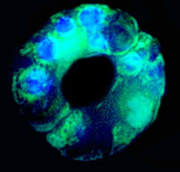UCSD Researchers Decipher Molecular 'Code' Capable of Controlling Plant Water Loss During Droughts
June 28, 2001
Media Contact: By: Kim McDonald

Photo of a pair of guard cells surrounding an open stomatal. Credit: G. Allen and J. Schroeder, UCSD
Scientists have succeeded in deciphering the chemical signaling mechanism that allows plants to close their stomata-the tiny pores in leaves through which gases and water vapor flow during photosynthesis and respiration-for extended periods.
The discovery of this signaling mechanism, a kind of biological Morse code used by plants to control the opening and closing of stomata, is described in the June 28 issue of Nature by biologists at the University of California, San Diego working with two German collaborators. Their achievement opens up a new area of study for plant scientists and may one day allow them to engineer drought-resistant crops that can more effectively survive water shortages by limiting water loss during droughts.
"Much of the land used for agriculture is not irrigated because water is either unavailable or too expensive," says Julian I. Schroeder, a professor of biology at UCSD who headed the research team. "So if crops can be engineered to respond to droughts by more rapidly and effectively closing their stomatal pores, where 95 percent of the water loss in plants occur, they could better survive drought periods by conserving water until the next rain hits. The commercial impact would be substantial. In the past decade, the average loss in the corn crop in the United States during three major droughts was 30 percent."
In their study, the scientists discovered that specialized cells in the leaves called guard cells that surround each pore, or stoma, "tune in" to the frequency of calcium oscillations in the cell, just as we might tune into a specific radio signal on the FM dial. When these oscillations of calcium concentrations in the cell are at just the right frequency, the scientists discovered, the guard cells respond by closing the stomata for extended periods. When the oscillations are not at the right frequency, the stomata-which initially close in response to elevations in calcium-reopen within an hour.
"Plants are smarter than we thought they were," says Gethyn J. Allen, a UCSD biologist and the first author of the research paper. "They can tune in to appropriate stimuli and tune out inappropriate stimuli. The guard cells can read the oscillations and modify their behavior. If the calcium oscillations are either too fast or too slow, the guard cells can sense that and the stomata will open up again."
Plant scientists have for more than a decade suspected that calcium oscillations might play a role in the opening and closing of stomata. The UCSD scientists were able to prove this was the case and crack the calcium code by conducting a series of experiments on a normal and a mutant form of the common laboratory plant, Arabidopsis.
The researchers showed that elevated calcium concentrations in the guard cells of normal plants produced short-term closures of the stomata for less than an hour. But long-term closures-more than three hours-were evident only when the oscillation of calcium reached a specific frequency. Studying a mutant provided by Erwin Grill at the Technical University of Munich, that is insensitive to a hormone, ABA, secreted by plants under drought-stress conditions, the scientists received further confirmation of the calcium-oscillation frequency required for long-term closures of stomata.
One effect of the mutant's insensitivity to the drought-stress hormone is that it produces rapid calcium oscillations, far too rapid to stimulate the guard cells to close. But by experimentally slowing down the calcium oscillations in the mutant to the same frequency at which normal Arabidopsis close their stomata for long periods, Allen, Schroeder and their colleagues were able to demonstrate that the mutant's stomata could also be closed for long periods.
"Scientists have speculated for years that there may be a code imbedded in the calcium signals and what we've done, essentially, is to crack this calcium code," says Schroeder, whose colleagues in the study included UCSD biologists Sarah P. Chu, Carrie L. Harrington and Yat Y. Yang; Thomas Hoffmann of the Technical University of Munich; and Karin Schumacher of the University of Tubingen, who participated in the experiments at UCSD.
Schroeder emphasizes that his team's discovery is still very much in the realm of basic research and far from any practical applications. "We don't know how to genetically engineer a plant to hit the right frequency to close its stomata in response to a drought," he says. "That lies in the future. But understanding this calcium code means we can now learn more about the mechanisms that control a plant's resistance to drought conditions."
"It's given us clues of where to look for the genes and proteins that control the closure of stomata," says Allen. "These are some of the unknown pieces of the puzzle."
The UCSD team's research was supported by grants from the National Institutes of Health, Department of Energy and the National Science Foundation.
